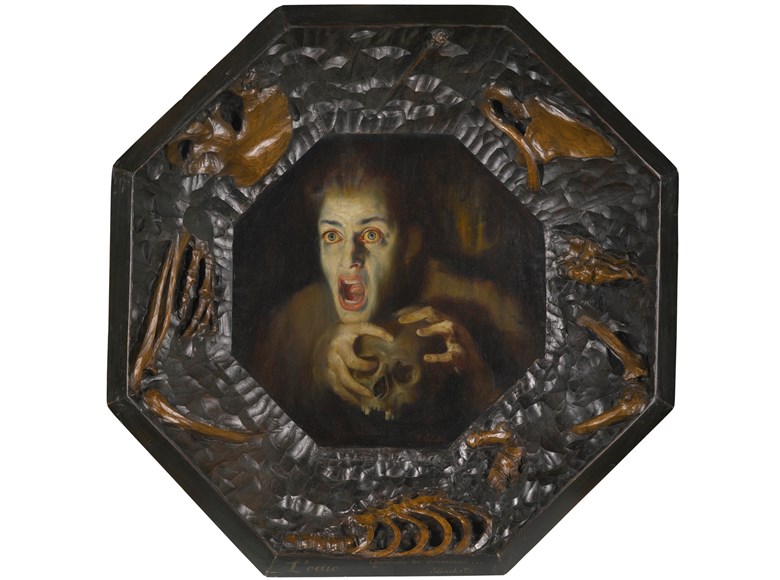 BACK TO GALLERY
BACK TO GALLERY
French & Company
Pasko Vucetic
Hatred and Madness
A perfect marriage of canvas and frame, a deranged man holds the skull of his former lover.
34 x 34 inches
description
After digging in the soil, a deranged man with bloodshot eyes and a ghoulish complexion has reached his goal. Scattered around him is the skeleton of the woman who scorned him in life. His hatred for her unabated, he has unearthed her remains, which he plans to nail to a pillory.
This alarming image by the Serbian artist Pasko Vucetic was inspired by an 1877 poem
Il Canto del Odio (The Ballad of Hatred) by the Italian poet Olindo Guerrini whose nom de plume was Lorenzo Strecchetti. Vucetic painted the work at the turn of the century, while Victor Kovacic, a Croatian architect, made the octagonal, ebonized and polychrome frame shortly thereafter.
Many European fin-de-siècle artists were fascinated with the sinister. This trend, called Dark Romanticism, had its origins in the macabre works of Goya and the nightmarish scenes by Fusseli. Later 19th century artists such as Moreau, Redon, Knopff, Ensor, Munch and Stuck painted images that reflected a tension between Eros and Thanatos; ecstasy and terror; and women and sin. With the appearance of Vucetic’s and Kovacic’s work, the geographical reach of such themes can be extended to Serbia and Croatia.
A practice common to many Symbolist artists was the integration of the painting, frame and setting. Here the union of the fine and the decorative arts is complete. Around the deep cove of the frame, whose gauges resemble soil, the madman has strewn the rib cage, fibula, hand and hipbones of the lover whose painted skull he holds. At the top of the frame is the nail pin he will use to complete his gory deed. By extending the frame far from the wall, the viewer is engulfed in this nightmarish act.
The response of many artists to the end of the century included prophesies of doom and decline. The books of Edgar Alan Poe were popular. Bram Stoker completed Dracula in 1897 and Freud published The Interpretation of Dreams in 1899. Wagner and Straus, meanwhile, entertained and frightened audiences with bloody and bizarre operas, and the philosopher Nietzsche predicted approaching catastrophes.
Today, these themes often lead to box office success, popular TV shows and record auction prices, as witnessed by Edvard Munch’s The Scream. Holding her skull and poking the eye socket with a long finger, Vucetic’s madman gives out a similar blood-curdling cry.
This alarming image by the Serbian artist Pasko Vucetic was inspired by an 1877 poem
Il Canto del Odio (The Ballad of Hatred) by the Italian poet Olindo Guerrini whose nom de plume was Lorenzo Strecchetti. Vucetic painted the work at the turn of the century, while Victor Kovacic, a Croatian architect, made the octagonal, ebonized and polychrome frame shortly thereafter.
Many European fin-de-siècle artists were fascinated with the sinister. This trend, called Dark Romanticism, had its origins in the macabre works of Goya and the nightmarish scenes by Fusseli. Later 19th century artists such as Moreau, Redon, Knopff, Ensor, Munch and Stuck painted images that reflected a tension between Eros and Thanatos; ecstasy and terror; and women and sin. With the appearance of Vucetic’s and Kovacic’s work, the geographical reach of such themes can be extended to Serbia and Croatia.
A practice common to many Symbolist artists was the integration of the painting, frame and setting. Here the union of the fine and the decorative arts is complete. Around the deep cove of the frame, whose gauges resemble soil, the madman has strewn the rib cage, fibula, hand and hipbones of the lover whose painted skull he holds. At the top of the frame is the nail pin he will use to complete his gory deed. By extending the frame far from the wall, the viewer is engulfed in this nightmarish act.
The response of many artists to the end of the century included prophesies of doom and decline. The books of Edgar Alan Poe were popular. Bram Stoker completed Dracula in 1897 and Freud published The Interpretation of Dreams in 1899. Wagner and Straus, meanwhile, entertained and frightened audiences with bloody and bizarre operas, and the philosopher Nietzsche predicted approaching catastrophes.
Today, these themes often lead to box office success, popular TV shows and record auction prices, as witnessed by Edvard Munch’s The Scream. Holding her skull and poking the eye socket with a long finger, Vucetic’s madman gives out a similar blood-curdling cry.






 SEND AN EMAIL
SEND AN EMAIL
 (212) 535-3330
(212) 535-3330